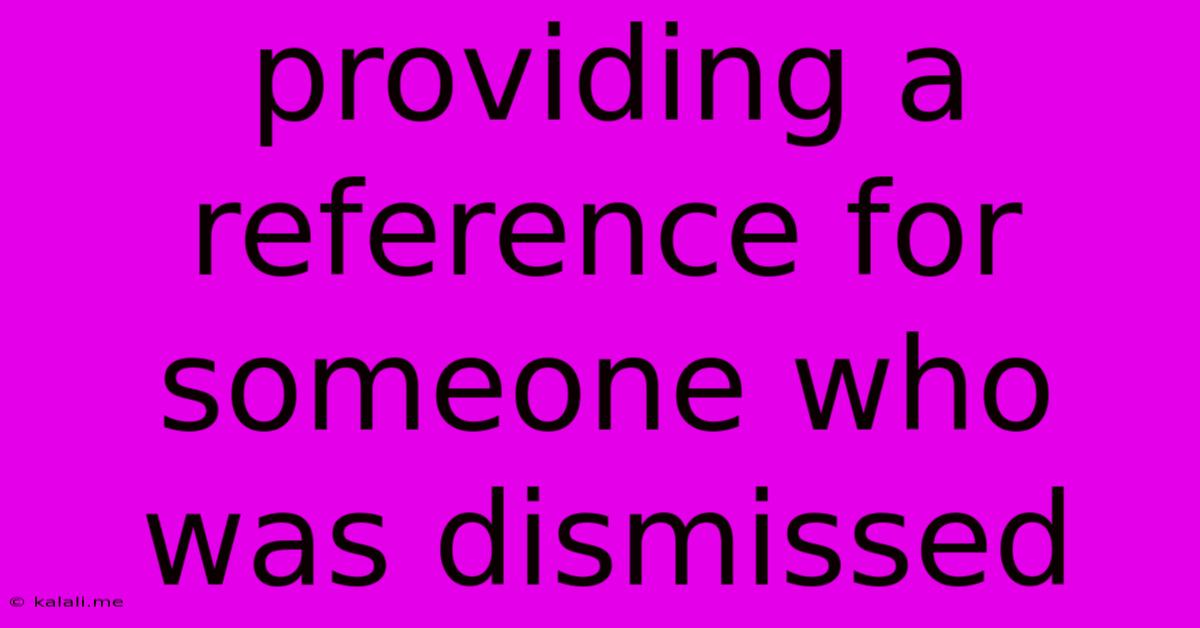Providing A Reference For Someone Who Was Dismissed
Kalali
May 19, 2025 · 3 min read

Table of Contents
Providing a Reference for Someone Who Was Dismissed: A Guide for Employers
Providing a reference for a former employee, especially one who was dismissed, can be a delicate situation. This guide offers advice on how to navigate this challenging scenario ethically and legally, minimizing potential risks for both you and the dismissed employee. Understanding the legal implications and crafting a responsible reference letter are crucial.
Understanding the Legal Landscape
Many jurisdictions have laws protecting employers from defamation lawsuits when providing references. However, this protection often hinges on providing truthful and factual information, avoiding subjective opinions, and refraining from making misleading statements. Providing incomplete information can also expose you to legal risk. It’s crucial to check your local laws and regulations regarding employment references before proceeding. Remember, silence can be interpreted as a tacit endorsement, so carefully consider all options.
Should You Provide a Reference at All?
Before committing to write a reference, consider the following:
- The Reason for Dismissal: Was the dismissal due to gross misconduct, performance issues, or other factors? If the dismissal involved serious misconduct, providing a positive reference could be misleading and even legally risky.
- Your Comfort Level: Are you comfortable discussing the employee's dismissal and providing an honest (yet legally protected) assessment of their performance? If you're unsure or uncomfortable, it's better to decline the request.
- Company Policy: Does your company have a policy regarding providing references for dismissed employees? Adhering to company policy is crucial to avoid legal complications.
Crafting a Responsible Reference Letter
If you decide to provide a reference, focus on facts and avoid subjective opinions. Here's a suggested structure:
1. Introduction: Briefly state your relationship with the former employee and the period of their employment. For example: "I was [Your Title] at [Company Name] from [Start Date] to [End Date], during which time [Employee Name] worked as a [Job Title]."
2. Job Responsibilities and Achievements: Describe the employee's key responsibilities and highlight any significant achievements or contributions during their employment. Quantify accomplishments whenever possible. For example: "During their tenure, [Employee Name] consistently exceeded sales targets, achieving a [Percentage]% increase year-over-year." Focus on factual data, rather than opinions.
3. Skills and Abilities: Highlight relevant skills and abilities demonstrated by the employee. Avoid subjective statements like "a hard worker" and instead provide concrete examples. For instance: "[Employee Name] demonstrated strong proficiency in project management, successfully leading the [Project Name] initiative on time and within budget."
4. Addressing the Dismissal (Carefully): This is the most sensitive part. Avoid stating the reason for dismissal directly, especially if it involves negative attributes. You might offer a neutral statement such as: "Their employment with [Company Name] concluded on [Date]." This avoids making potentially false statements.
5. Conclusion: Reiterate your willingness to answer any further questions and provide contact information. You could also add a statement like: "I am happy to answer any further questions you may have."
What NOT to Include:
- Subjective opinions: Avoid using vague terms like "difficult to work with" or "unmotivated."
- Confidential information: Do not disclose personal information or details not relevant to their job performance.
- Unverified information: Only include information you know to be true and verifiable.
- False statements: Providing false information can lead to legal repercussions.
Alternatives to a Traditional Reference:
If you're uncomfortable providing a full reference, consider these alternatives:
- Verification of employment: Confirm dates of employment and job title.
- Neutral statement: Offer a concise statement confirming employment without providing an opinion on performance.
Providing a reference for a dismissed employee requires careful consideration. By following these guidelines, you can minimize risk while providing a responsible and factual account of the employee's time with your organization. Always prioritize honesty, accuracy, and adherence to both legal and ethical standards.
Latest Posts
Latest Posts
-
Can You Reverse A Bank Transfer
May 19, 2025
-
Leak From Pipe At Back Of Toilet
May 19, 2025
-
Can You Reheat Sausages In Microwave
May 19, 2025
-
Can A Cat Eat A Rabbit
May 19, 2025
-
Can Cling Film Go In The Oven
May 19, 2025
Related Post
Thank you for visiting our website which covers about Providing A Reference For Someone Who Was Dismissed . We hope the information provided has been useful to you. Feel free to contact us if you have any questions or need further assistance. See you next time and don't miss to bookmark.